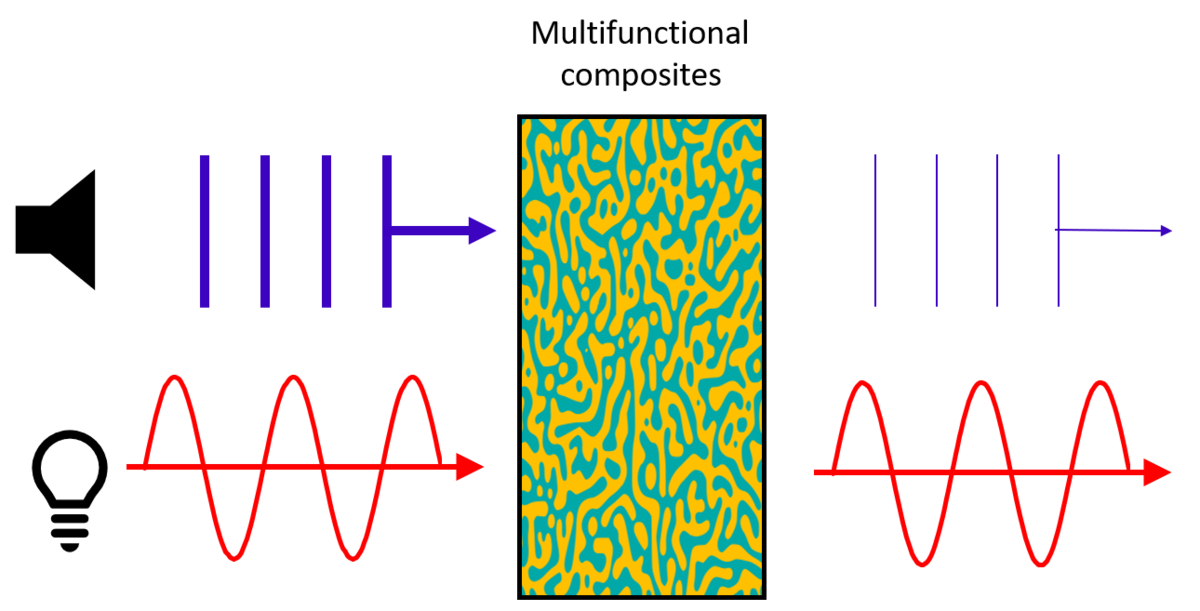Torquato Research Links Elastodynamic and Electromagnetic Wave Phenomena
This research was accepted for journal publication prior to the Covid-19 outbreak. We post it today to honor the ongoing dedication to our mission of education and research.
Imagine the advances to predictive modeling if you could infer something about how light amplifies colors in a bird’s plumage from the way seismic waves propagate through mountain systems.
That’s a bit of hyperbole that nevertheless suggests the “beautiful” utility of new mathematical formulas devised by Princeton Professor of Chemistry Salvatore Torquato and sixth-year graduate student Jaeuk Kim of the Department of Physics as they advance our understanding of how different types of waves behave inside materials.

Photo by C. Todd Reichart
Torquato, the Lewis Bernard Professor of Natural Sciences and director of the Complex Materials Theory Group, published research this week in the Proceedings of the National Academy of Sciences (PNAS) linking wave phenomena that has never previously been linked. For the first time, the research employs a unified approach that melds the behavior of elastodynamic (sound) waves with that of electromagnetic (light) waves as they propagate through heterogeneous, or composite, materials.
Torquato and Kim also demonstrate that the way these waves move through a heterogeneous material in turn elucidates characteristics of the material microstructure itself. The microstructure – the spatial arrangement of the different materials that comprise the heterogeneous material – impacts the way waves propagate.
This is the basic idea behind ultrasound scans, or sonography, that create images of structures within your body.
A homogeneous system consists of a single material. A heterogeneous, or composite, system is a mixture. But the mixture of these individual materials – called phases – do not combine evenly; they inhabit distinct domains within that system. Light and sound waves move through a given composite and, as they encounter different phases with different physical properties, they behave differently, scatter, and interfere. Due to the resulting interference, the wave speeds change and the waves can attenuate, or lose energy.
The formulas developed under this research will allow scientists to predict how waves act in these complex systems without having to solve for two sets of differential equations that govern light and sound waves, respectively. They can estimate the effective wave speeds and degree of attenuation, or the rate at which waves degrade within a material, for a wider range of wavelengths than that on which previous theories operate.
“What we’re predicting is the effective behavior of this wave through a complicated system,” said Torquato, a theoretical chemist. “And it turns out that the effective properties of both electromagnetic and elastodynamic waves will depend upon the wavelengths associated with those particular waves.
“Light waves, for instance, are governed by Maxwell’s differential equations for electromagnetic waves. Sound waves are governed by another set of differential equations. So normally, when you’re working on wave phenomena, you have these two communities that typically don’t talk to each other,” added Torquato. “What we have done, which is way out of the box, is to create a formulation that allows us to attack each problem in a unified manner.
“Then, we melded the formulas together to show that if you can tell me the response of a material to an electromagnetic wave, I can tell you something about the response of that same material to sound waves. So now, you have these predictive formulas that can be applied so that you don’t have to constantly validate the theory via full-blown computer simulations every time you change the parameters. You’re able to access and predict phenomena that people could not even contemplate before.”

Illustration by Jaeuk Kim
The research centers on heterogeneous systems because these systems are ideal to achieve multiple types of desired properties, called multifunctionality, which means that the best properties of composites can be combined to exhibit specific responses to the different types of waves. Materials can then be designed to absorb waves or allow them to be transmitted without attenuation.
“Previous multifunctional designs mainly have focused on static transport and elastic properties because conventional theories were not accurate in predicting wave phenomena,” said Kim. “Thus, our theory will aid the rational design of multifunctional composites with desired wave characteristics.”
These formulas could allow for the design of new, multifunctional materials that exhibit specific responses to waves, paving the way to engineered hyperuniform materials with exotic effective properties. They could one day enable the design of multifunctional composites that might include structural components for spacecraft, which require high stiffness and electromagnetic absorption, or heat sinks for central processing units (CPUs) and other electrical devices that can simultaneously suppress mechanical vibrations.
“This work was successful thanks to Professor Torquato’s insights in working across disciplines. It was exciting to bridge the knowledge of two different communities – optics and acoustics – to achieve this research,” said Kim.
Read the full paper here: https://www.pnas.org/content/early/2020/04/08/1914086117
The paper, “Multifunctional Composites for Elastic and Electromagnetic Wave Propagation,” by Jaeuk Kim and Salvatore Torquato, appears in this week’s issue of the Proceedings of the National Academy of Sciences (PNAS: 2019-14086RR). The authors acknowledge the support of the Air Force Office of Scientific Research Program on Mechanics of Multifunctional Materials and Microsystems (award No. FA9550-18-1-0514). Inquiries: http://chemlabs.princeton.edu/torquato.
